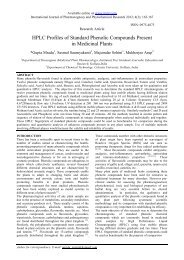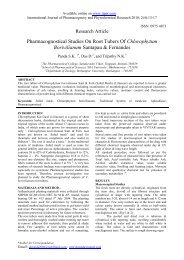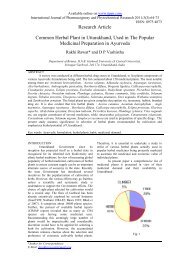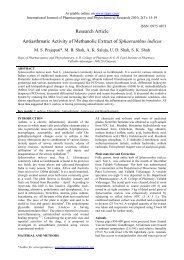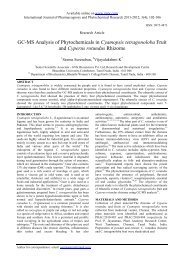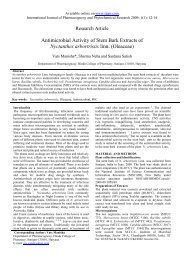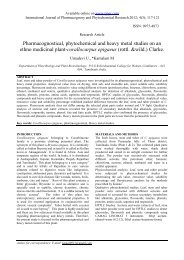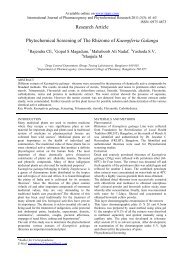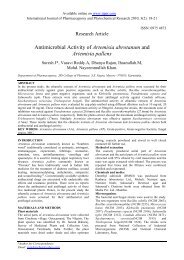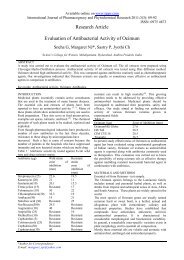Evaluation of Aphrodisiac Activity of Turnera aphrodisiaca
Evaluation of Aphrodisiac Activity of Turnera aphrodisiaca
Evaluation of Aphrodisiac Activity of Turnera aphrodisiaca
Create successful ePaper yourself
Turn your PDF publications into a flip-book with our unique Google optimized e-Paper software.
Suresh Kumar et al. / <strong>Evaluation</strong> <strong>of</strong> aphrodisiac activity <strong>of</strong> <strong>Turnera</strong> <strong>aphrodisiaca</strong>methanol due to prevalence <strong>of</strong> sedative effects. Volatile oildid not exhibit aphrodisiac activity at any <strong>of</strong> the doses tested(Table 3). A dose dependent increase in aphrodisiac activitywas observed in alkaloidal fraction upon acute as well assubacute administration during 2nd h <strong>of</strong> interaction (Table 4-5). Male mice showed maximum aphrodisiac activity uponsub-acute administration <strong>of</strong> alkaloidal fraction. Thisobservation infers that T. <strong>aphrodisiaca</strong> improves reproductiveorgans upon long term use.One more interesting observation is that crude methanolextract and purified alkaloidal fraction exhibited significantaphrodisiac activity at similar dose, i.e., 50 mg/kg. Thisobservation suggests that one or more constituent(s) incombination with bioactive alkaloid possess synergisticbeneficial effects on reproductive organs. Bioactivity directedfractionation, using various chromatography techniques, workis in progress to isolate bioactive alkaloid from T.<strong>aphrodisiaca</strong>.AcknowledgementsAuthors duly acknowledge the financial assistance providedby University Grants Commission, New Delhi to SureshKumar for this research work.References1. Aguilara FJA, Ramos RR, Gutirrez SP, Contretras AA,Weber CCC, Saenz JLF (1998): Study <strong>of</strong> the antihyperglycaemiceffect <strong>of</strong> plants used as antidiabetics. JEthnopharmacol 61: 101-110.2. Arletti R, Benelli A, Cavazzuti E, Scarpetta G, Bertolini A(1999): Stimulating property <strong>of</strong> <strong>Turnera</strong> diffusa and Pfaffiapaniculata extracts on the sexual behavior <strong>of</strong> male rats.Psychopharmacology 143: 15-19.3. Auterh<strong>of</strong>f H, Hackle HP (1968): Components <strong>of</strong> damianadrug. Archiv Pharm 301: 537-544.4. Boericke W (1988). Pocket Manual <strong>of</strong> HomoeopathicMateria Medica. New Delhi, India, B. Jain PublisherPrivate Limited, p. 659.5. British Herbal Pharmacopoeia (1983). West Yorks, BritishHerbal Medicine Association, p. 29.6. Caceres A (1996): <strong>Turnera</strong> <strong>aphrodisiaca</strong>. In: Giron L,Caceres A, eds., Plantas de Uso Medicinal en Guatemala.Editorial Universataria San Carlos de Guatemala, pp. 160-162.7. Dominguez XA, Hinojosa M (1976): Mexican medicinalplants. XXVIII. Isolation <strong>of</strong> 5-hydroxy-7, 3', 4'-trimethoxy flavone from <strong>Turnera</strong> diffusa. Planta Med 30:68-71.8. Fryer FA (1965): Chemical investigation <strong>of</strong> damiana(<strong>Turnera</strong> diffusa). Specialities 1: 21-23.9. Hocking GM, Thomas CC (1955). A Dictionary <strong>of</strong> Termsin Pharmacognosy. Illinois, USA, Springfield, p. 234.10. Koch L (1936): Drug collection from Boliviasystematically, anatomically and chemically examined.Arch Pharmacol 274: 343-369.11. Kumar S, Sharma A (2005): Anti-anxiety activity studies<strong>of</strong> various extracts <strong>of</strong> <strong>Turnera</strong> <strong>aphrodisiaca</strong> Ward. J HerbPharmacother 5: 13-21.12. Kumar S, Sharma A (2006): Apigenin – The anxiolyticconstituent <strong>of</strong> <strong>Turnera</strong> <strong>aphrodisiaca</strong> Ward. Pharm Biol 44:84-90.13. Osol A, Farrar GF, Leuallen EE, Youngken HW, DetweilerDK (1947). Dispensatory <strong>of</strong> United States <strong>of</strong> America(24th edition). Philadelphia, J. B. Lippincott Company, pp.1422-1423.14. Parfitt K (1999). Martindale, the Complete Drug Reference(32nd edition). 1 Lambeth High Street, London,Pharmaceutical Press, p. 1570.15. Perez RM, Ocegueda A, Munoz JL, Avita JG, MorrowWW (1984): A study <strong>of</strong> the hypoglycaemic effect <strong>of</strong> someMexican plants. J Ethnopharmacol 12: 253-262.16. Saggese D (1959). Medicinal Herbs <strong>of</strong> Argentina (10thedition). Rosario, Argentina, Antoghazzi & Co., pp. 1-189.17. Scheffer WC (1980). Statistics for the Biological Sciences.Philippines, Addison-Wesley Publishing Company, Inc.,pp. 121-141.18. Spencer KC, Seigler DS (1981): Tetraphyllin B from<strong>Turnera</strong> diffusa. Planta Med 43: 175-178.19. Steinmetz EF (1960): Damianae folia. Acta Phytotherapeut7: 1-2.20. Subramoniam A, Madhavachandran R, RajasekharanS, Pushpangadan P (1997): <strong>Aphrodisiac</strong> property <strong>of</strong>Trichopus zeylanicus extract in male mice. JEthnopharmacol 57: 21-27.IJPPR September-November,2009, Vol 1, Issue 1(1-4) 4



